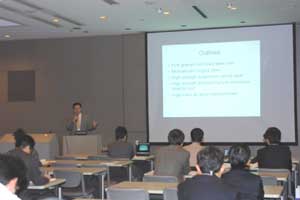|
|
|
|
|
|
Report on gThe Second Japan-China Workshop on Automobile Materials for Environment and Safety (AMES 2004)h
 The Second Japan-China Workshop on Automobile Materials for Environment
and Safety (AMES 2004) was held in the #1 Conference Room, Sengen site on
Thursday, March 11, 2004. In May 2002, our center and CISRI signed a
Memorandum of Understanding (MOU), and this workshop was an undertaking of
a specific cooperation activity based on the conclusion of the MOU. The
first one was held in Shanghai, China on Friday, September 20, 2002.
The Second Japan-China Workshop on Automobile Materials for Environment
and Safety (AMES 2004) was held in the #1 Conference Room, Sengen site on
Thursday, March 11, 2004. In May 2002, our center and CISRI signed a
Memorandum of Understanding (MOU), and this workshop was an undertaking of
a specific cooperation activity based on the conclusion of the MOU. The
first one was held in Shanghai, China on Friday, September 20, 2002.
The theme of this second workshop was environment/safety and materials. The topics for the workshop were provided from the aspects of automobile production without utilizing environmentally burdening substances, automobile production that considers more recycling, automobile production with better safety, and from various topics regarding materials. The workshop was planned to clarify the topics that should be collaborated on by the two countries.
There was a total of 10 presentations, 5 from China and 5 from Japan (http://www.nims.go.jp/Auto-WS2004/topE.html), and meaningful discussions were held throughout these sessions. Some comments from the Chinese side that gathered special attention from both the presentations and the questions and answers period are shown below, not necessarily in the order stated.
gChina, Japan, and Korea control almost 40% of the worldfs steel
production and automobile manufacturing, and these values are expected to
increase to 50% in the near future.h
gThe production of crude steel in China will reach 2.5 tons in 2005 and
will probably exceed 3 tons in 2010. Resource and environmental problems
that result will become a life and death problem.h (CISRI)
gIt has taken China 12 years till 2002 to produce 1 million tons of
steel sheets for automobiles; however, it has taken them only one year to
increase that amount from 1 to 2 million tons. The production of high
strength steels will continue to increase as a result of fuel efficiency
and safety.h
g80% of the high strength steels at Baosteel are a dual phase steel, and
they are producing steel up to 781 Mpa.h(Baosteel)
gRegulations regarding the fuel efficiency and the amount of CO2 that
is released are strict in EU and Japan. China is also looking into the
regulations for fuel efficiency and is planning to enforce them in 2008.h
gThe material cost for Mg and Al are basically the same in China. A policy
for utilizing Mg in automobiles is being promoted.h(FAW)
g1390 MPa high strength bolt (ADF1) was installed into a small scale
bus, the IVECO model A59.21, and the in-vehicle test on reliability was
passed.h
gADF bolt was screw shaped by cold form rolling following QT. The residual
compressive stress was utilized, and the subject of die life was
resolved.h (YUEJIN Motors)
gThe 1490 MPa bolt was manufactured on an experimental basis and passed the engine rig test twice. The atmospheric corrosion tests have been conducted at the yield stress level from May 2002 till the present and have not shown any fracture.h (CISRI)
In these ways, China is exhibiting the following characteristics:
-
its production is expanding rapidly
-
the development and the application of highly efficient materials as a measure towards the problems of resources and safety are flourishing
-
the movement towards the legislation for the various types of regulations that are being considered as a measure for the ever increasing environmental problems is making progress
The third AMES is scheduled for two years from now in China. We must strengthen our cooperation with the specialists of resources and safety so that we can investigate resources/environment and safety which is a life and death problem for both countries in much detail.
(Kaneaki Tsuzaki, Deputy Director-General, Steel Research Center)
[Back]